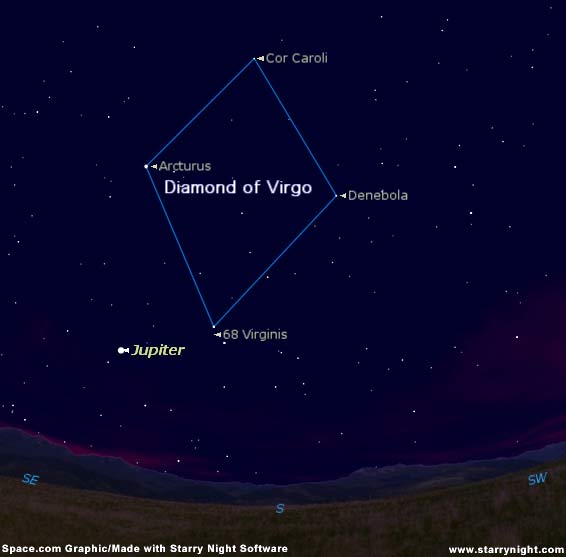Four-Star Sight: The Celestial Diamond

With the bright Moon having moved out of the evening sky, we now have an opportunity to view some of the fainter sky objects that now occupy our spring evening sky.
Looking high overhead and toward the south just after nightfall, is a broad star pattern formed by four stars. The third magnitude star, Cor Caroli, is the faintest of the four that comprise a large diamond frame that can be found high in the sky and due south at around 10 p.m. local daylight time.
The other stars in the diamond are second magnitude Denebola (marking the tail of Leo, the Lion), first magnitude Spica (the spike of wheat in the hand of Virgo) and zero-magnitude Arcturus (in Bootes). [Map]
Remember that the lower the figure of magnitude, the brighter the star. And if you ever wanted to get a good visual idea of star magnitudes, here's some celestial numerology: in this four-star pattern we have that part of the magnitude scale running from 0 down to 3. And not too far away to the southeast of the diamond is Jupiter glowing at magnitude -2.5.
The Great Diamond, or ...
Astronomy popularizer Hans A. Rey (1898-1977) called it the "Virgin's Diamond," though others refer to it simply as "The Great Diamond."
At first glance, the Great Diamond appears to encompass a rather dull region of the sky. The Diamond itself appears about as wide as the Big Dipper and about twice as long.
Breaking space news, the latest updates on rocket launches, skywatching events and more!
In the upper right part of the Diamond is the faint fuzz of stars belonging to Coma Berenices (Berenice's Hair). But also located within the Diamond is one of the most remarkable areas of the heavens. Sometimes called the Coma-Virgo Cloud of Galaxies, and often referred to in older astronomy texts as "The Field of the Nebulae," it is here that lies a veritable treasure trove of numerous star cities.
Galaxy bonanza
Thousands of galaxies have been photographed here with great observatory instruments. If you own a good reflecting telescope of at least 6-inch aperture or greater, a sweep of this region will reveal literally dozens of these galaxies appearing as a myriad of faint and fuzzy patches of light. This is the only great cloud of galaxies that is available to the average amateur.
Just try to remember that each and every one of these dim blobs is a star city, which likely contains tens of billions of stars!
And keep in mind that this cluster or cloud of galaxies is the nearest of the large aggregations of galaxies relative to our own. The best estimates indicate that it is located somewhere between 40 and 70 million light-years from us.
So it is possible that as you run across these pale little patches of light in your telescope, irregularly shaped, round or elongated in appearance, that you are gazing upon galaxies whose light may have started toward the Earth around the time of the extinction of the dinosaurs!
Basic Sky Guides
- Full Moon Fever
- Astrophotography 101
- Sky Calendar & Moon Phases
- 10 Steps to Rewarding Stargazing
- Understanding the Ecliptic and the Zodiac
- False Dawn: All about the Zodiacal Light
- Reading Weather in the Sun, Moon and Stars
- How and Why the Night Sky Changes with the Seasons
- Night Sky Main Page: More Skywatching News & Features
Joe Rao serves as an instructor and guest lecturer at New York's Hayden Planetarium. He writes about astronomy for The New York Times and other publications, and he is also an on-camera meteorologist for News 12 Westchester, New York.
| DEFINITIONS |
1 AU, or astronomical unit, is the distance from the Sun to Earth, or about 93 million miles. Magnitude is the standard by which astronomers measure the apparent brightness of objects that appear in the sky. The lower the number, the brighter the object. The brightest stars in the sky are categorized as zero or first magnitude. Negative magnitudes are reserved for the most brilliant objects: the brightest star is Sirius (-1.4); the full Moon is -12.7; the Sun is -26.7. The faintest stars visible under dark skies are around +6. Degrees measure apparent sizes of objects or distances in the sky, as seen from our vantage point. The Moon is one-half degree in width. The width of your fist held at arm's length is about 10 degrees. The distance from the horizon to the overhead point (called the zenith) is equal to 90 degrees. Declination is the angular distance measured in degrees, of a celestial body north or south of the celestial equator. If, for an example, a certain star is said to have a declination of +20 degrees, it is located 20 degrees north of the celestial equator. Declination is to a celestial globe as latitude is to a terrestrial globe. Arc seconds are sometimes used to define the measurement of a sky object's angular diameter. One degree is equal to 60 arc minutes. One arc minute is equal to 60 arc seconds. The Moon appears (on average), one half-degree across, or 30 arc minutes, or 1800 arc seconds. If the disk of Mars is 20 arc seconds across, we can also say that it is 1/90 the apparent width of the Moon (since 1800 divided by 20 equals 90). |

Joe Rao is Space.com's skywatching columnist, as well as a veteran meteorologist and eclipse chaser who also serves as an instructor and guest lecturer at New York's Hayden Planetarium. He writes about astronomy for Natural History magazine, Sky & Telescope and other publications. Joe is an 8-time Emmy-nominated meteorologist who served the Putnam Valley region of New York for over 21 years. You can find him on Twitter and YouTube tracking lunar and solar eclipses, meteor showers and more. To find out Joe's latest project, visit him on Twitter.
